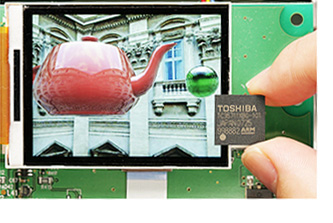Soon it will be more pleasant to play on a mobile phone than on a PSP
 The Japanese corporation Toshiba has developed a new graphics chip for mobile phones, which should significantly improve the quality of "mobile" three-dimensional graphics. According to the creators of the solution, the performance of the TC35711XBG is several times higher than modern counterparts. The chip is capable of processing up to 100 million polygons per second, while competitors are only a few million.
The Japanese corporation Toshiba has developed a new graphics chip for mobile phones, which should significantly improve the quality of "mobile" three-dimensional graphics. According to the creators of the solution, the performance of the TC35711XBG is several times higher than modern counterparts. The chip is capable of processing up to 100 million polygons per second, while competitors are only a few million.For example: the Sony Play Station Portable is capable of handling about 35 million polygons and about 665 million pixels per second. And the existing graphics accelerator chips for cell phones show a computing speed ten times less. The novelty will help software developers to develop applications that are more complex in terms of 3D graphics, including games.
')
Another important development feature is the ability to fully support programmable shaders. This will allow software developers to create more effective and realistic graphics. In addition, the new chip is capable of not only processing graphics, but also solving other problems. It includes a central processor, a proprietary Media Embedded Processor (MeP) for sound processing and a graphics controller for widescreen displays of WVGA phones (800 x 480 pixels). All this is placed on a single chip and is designed for installation in a cell phone. In addition, there is support for an SD memory card interface, a UART interface and a serial data receiving and transmitting port, as well as its own DDR memory controller.
The microcircuit has rather modest dimensions - 13x13x1.2 mm. The operating temperature is from -20 to +70 degrees Celsius, the supply voltage is 3 V. The ARM1176JZF-S processor capable of operating at a frequency of up to 550 MHz will be installed in the microchip.
According to Toshiba.co.jp, Toshiba’s mass production of microcircuits will begin in the second quarter of 2008, and the delivery of test samples at a price of $ 66 is scheduled for October this year.
Source: https://habr.com/ru/post/12359/
All Articles